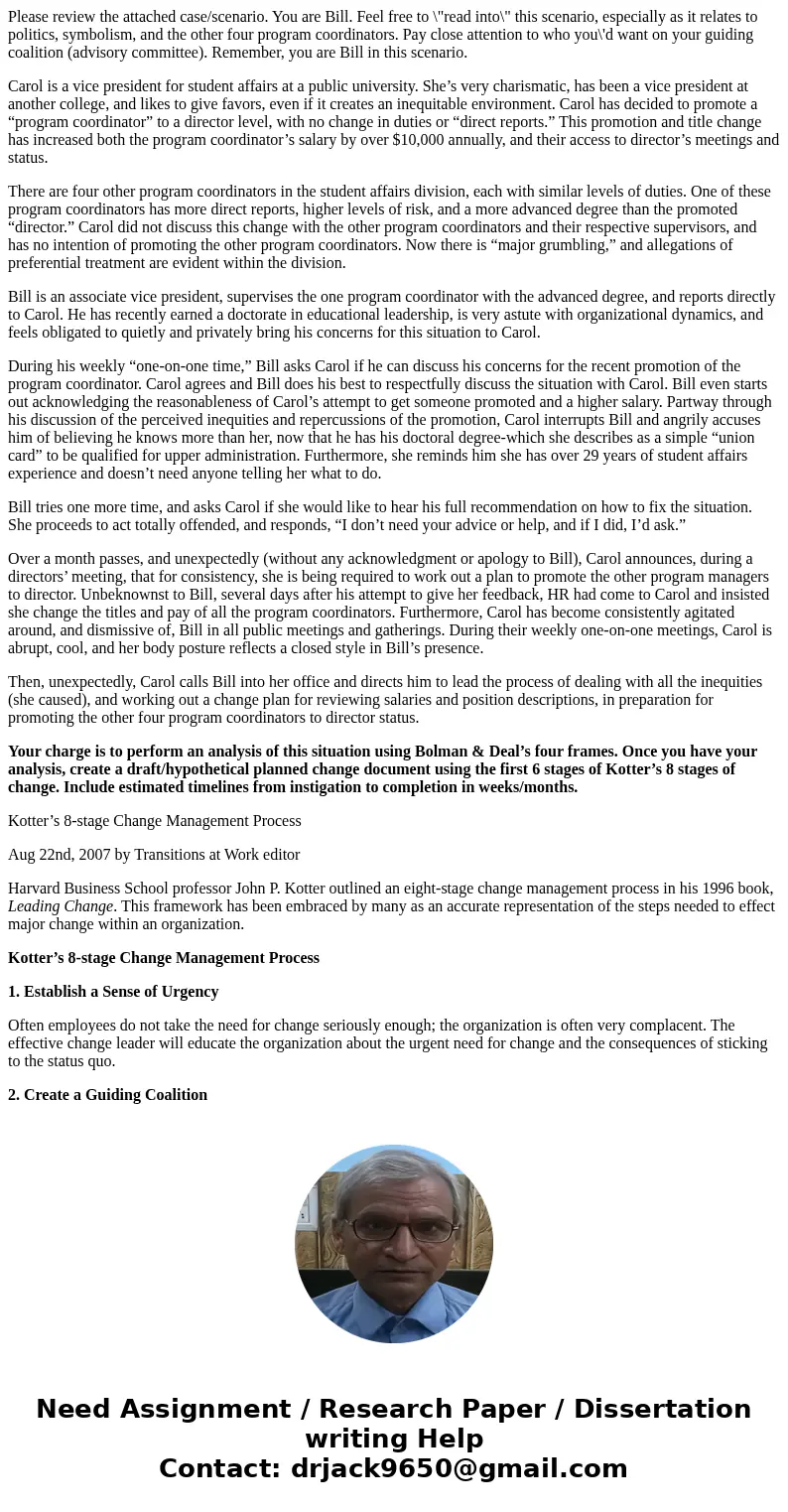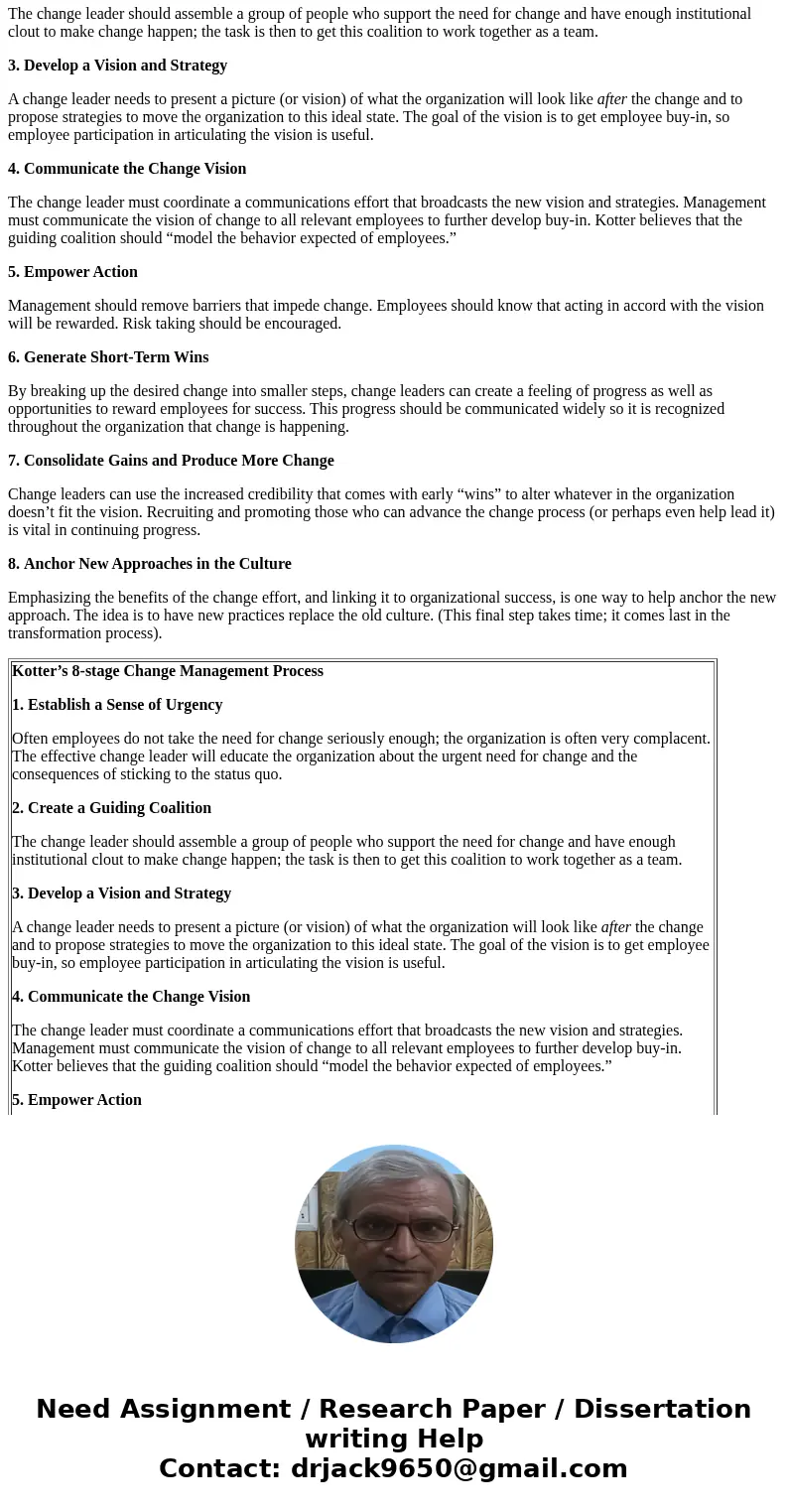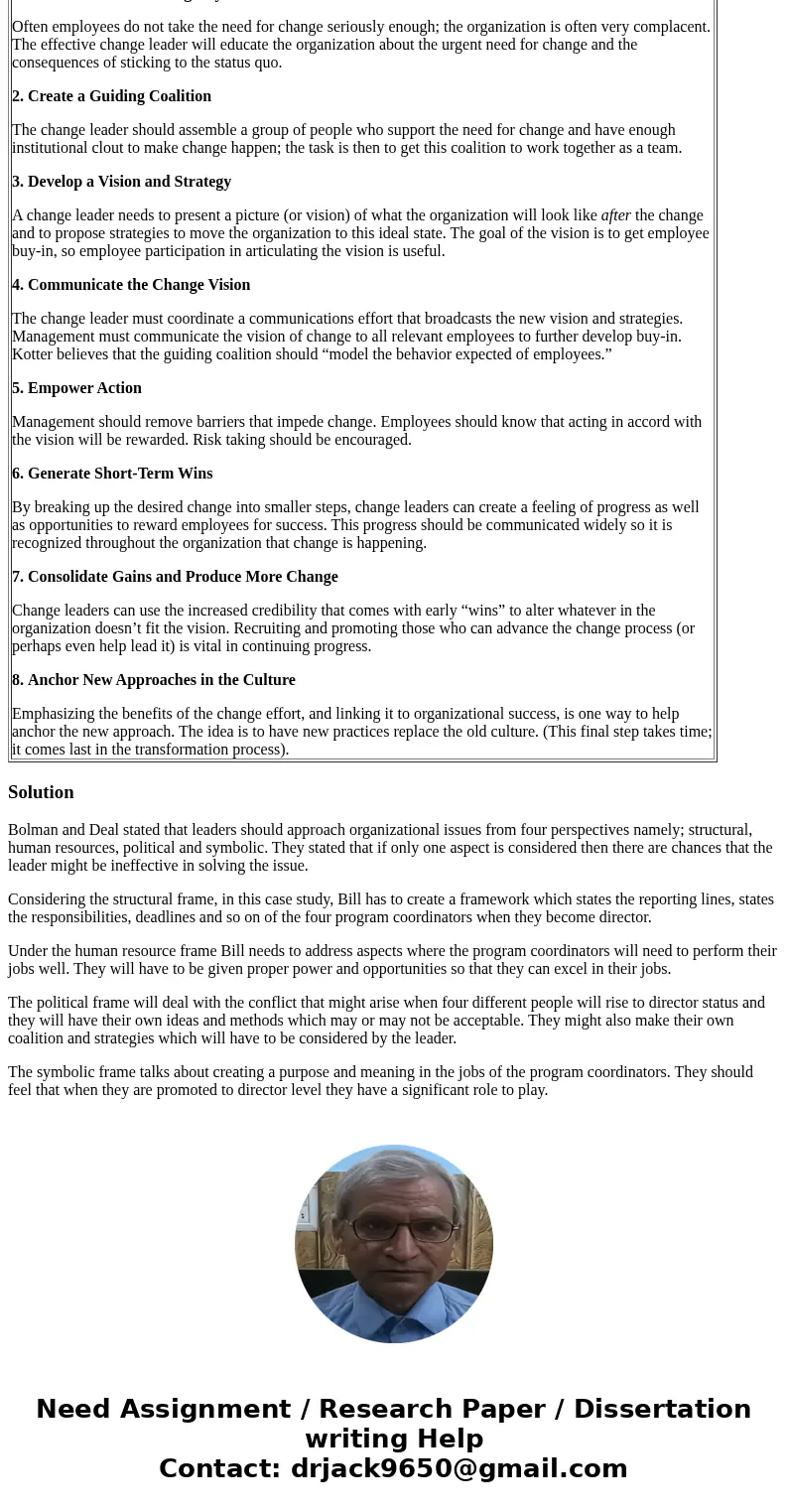Please review the attached casescenario You are Bill Feel fr
Please review the attached case/scenario. You are Bill. Feel free to \"read into\" this scenario, especially as it relates to politics, symbolism, and the other four program coordinators. Pay close attention to who you\'d want on your guiding coalition (advisory committee). Remember, you are Bill in this scenario.
Carol is a vice president for student affairs at a public university. She’s very charismatic, has been a vice president at another college, and likes to give favors, even if it creates an inequitable environment. Carol has decided to promote a “program coordinator” to a director level, with no change in duties or “direct reports.” This promotion and title change has increased both the program coordinator’s salary by over $10,000 annually, and their access to director’s meetings and status.
There are four other program coordinators in the student affairs division, each with similar levels of duties. One of these program coordinators has more direct reports, higher levels of risk, and a more advanced degree than the promoted “director.” Carol did not discuss this change with the other program coordinators and their respective supervisors, and has no intention of promoting the other program coordinators. Now there is “major grumbling,” and allegations of preferential treatment are evident within the division.
Bill is an associate vice president, supervises the one program coordinator with the advanced degree, and reports directly to Carol. He has recently earned a doctorate in educational leadership, is very astute with organizational dynamics, and feels obligated to quietly and privately bring his concerns for this situation to Carol.
During his weekly “one-on-one time,” Bill asks Carol if he can discuss his concerns for the recent promotion of the program coordinator. Carol agrees and Bill does his best to respectfully discuss the situation with Carol. Bill even starts out acknowledging the reasonableness of Carol’s attempt to get someone promoted and a higher salary. Partway through his discussion of the perceived inequities and repercussions of the promotion, Carol interrupts Bill and angrily accuses him of believing he knows more than her, now that he has his doctoral degree-which she describes as a simple “union card” to be qualified for upper administration. Furthermore, she reminds him she has over 29 years of student affairs experience and doesn’t need anyone telling her what to do.
Bill tries one more time, and asks Carol if she would like to hear his full recommendation on how to fix the situation. She proceeds to act totally offended, and responds, “I don’t need your advice or help, and if I did, I’d ask.”
Over a month passes, and unexpectedly (without any acknowledgment or apology to Bill), Carol announces, during a directors’ meeting, that for consistency, she is being required to work out a plan to promote the other program managers to director. Unbeknownst to Bill, several days after his attempt to give her feedback, HR had come to Carol and insisted she change the titles and pay of all the program coordinators. Furthermore, Carol has become consistently agitated around, and dismissive of, Bill in all public meetings and gatherings. During their weekly one-on-one meetings, Carol is abrupt, cool, and her body posture reflects a closed style in Bill’s presence.
Then, unexpectedly, Carol calls Bill into her office and directs him to lead the process of dealing with all the inequities (she caused), and working out a change plan for reviewing salaries and position descriptions, in preparation for promoting the other four program coordinators to director status.
Your charge is to perform an analysis of this situation using Bolman & Deal’s four frames. Once you have your analysis, create a draft/hypothetical planned change document using the first 6 stages of Kotter’s 8 stages of change. Include estimated timelines from instigation to completion in weeks/months.
Kotter’s 8-stage Change Management Process
Aug 22nd, 2007 by Transitions at Work editor
Harvard Business School professor John P. Kotter outlined an eight-stage change management process in his 1996 book, Leading Change. This framework has been embraced by many as an accurate representation of the steps needed to effect major change within an organization.
Kotter’s 8-stage Change Management Process
1. Establish a Sense of Urgency
Often employees do not take the need for change seriously enough; the organization is often very complacent. The effective change leader will educate the organization about the urgent need for change and the consequences of sticking to the status quo.
2. Create a Guiding Coalition
The change leader should assemble a group of people who support the need for change and have enough institutional clout to make change happen; the task is then to get this coalition to work together as a team.
3. Develop a Vision and Strategy
A change leader needs to present a picture (or vision) of what the organization will look like after the change and to propose strategies to move the organization to this ideal state. The goal of the vision is to get employee buy-in, so employee participation in articulating the vision is useful.
4. Communicate the Change Vision
The change leader must coordinate a communications effort that broadcasts the new vision and strategies. Management must communicate the vision of change to all relevant employees to further develop buy-in. Kotter believes that the guiding coalition should “model the behavior expected of employees.”
5. Empower Action
Management should remove barriers that impede change. Employees should know that acting in accord with the vision will be rewarded. Risk taking should be encouraged.
6. Generate Short-Term Wins
By breaking up the desired change into smaller steps, change leaders can create a feeling of progress as well as opportunities to reward employees for success. This progress should be communicated widely so it is recognized throughout the organization that change is happening.
7. Consolidate Gains and Produce More Change
Change leaders can use the increased credibility that comes with early “wins” to alter whatever in the organization doesn’t fit the vision. Recruiting and promoting those who can advance the change process (or perhaps even help lead it) is vital in continuing progress.
8. Anchor New Approaches in the Culture
Emphasizing the benefits of the change effort, and linking it to organizational success, is one way to help anchor the new approach. The idea is to have new practices replace the old culture. (This final step takes time; it comes last in the transformation process).
| Kotter’s 8-stage Change Management Process 1. Establish a Sense of Urgency Often employees do not take the need for change seriously enough; the organization is often very complacent. The effective change leader will educate the organization about the urgent need for change and the consequences of sticking to the status quo. 2. Create a Guiding Coalition The change leader should assemble a group of people who support the need for change and have enough institutional clout to make change happen; the task is then to get this coalition to work together as a team. 3. Develop a Vision and Strategy A change leader needs to present a picture (or vision) of what the organization will look like after the change and to propose strategies to move the organization to this ideal state. The goal of the vision is to get employee buy-in, so employee participation in articulating the vision is useful. 4. Communicate the Change Vision The change leader must coordinate a communications effort that broadcasts the new vision and strategies. Management must communicate the vision of change to all relevant employees to further develop buy-in. Kotter believes that the guiding coalition should “model the behavior expected of employees.” 5. Empower Action Management should remove barriers that impede change. Employees should know that acting in accord with the vision will be rewarded. Risk taking should be encouraged. 6. Generate Short-Term Wins By breaking up the desired change into smaller steps, change leaders can create a feeling of progress as well as opportunities to reward employees for success. This progress should be communicated widely so it is recognized throughout the organization that change is happening. 7. Consolidate Gains and Produce More Change Change leaders can use the increased credibility that comes with early “wins” to alter whatever in the organization doesn’t fit the vision. Recruiting and promoting those who can advance the change process (or perhaps even help lead it) is vital in continuing progress. 8. Anchor New Approaches in the Culture Emphasizing the benefits of the change effort, and linking it to organizational success, is one way to help anchor the new approach. The idea is to have new practices replace the old culture. (This final step takes time; it comes last in the transformation process). |
Solution
Bolman and Deal stated that leaders should approach organizational issues from four perspectives namely; structural, human resources, political and symbolic. They stated that if only one aspect is considered then there are chances that the leader might be ineffective in solving the issue.
Considering the structural frame, in this case study, Bill has to create a framework which states the reporting lines, states the responsibilities, deadlines and so on of the four program coordinators when they become director.
Under the human resource frame Bill needs to address aspects where the program coordinators will need to perform their jobs well. They will have to be given proper power and opportunities so that they can excel in their jobs.
The political frame will deal with the conflict that might arise when four different people will rise to director status and they will have their own ideas and methods which may or may not be acceptable. They might also make their own coalition and strategies which will have to be considered by the leader.
The symbolic frame talks about creating a purpose and meaning in the jobs of the program coordinators. They should feel that when they are promoted to director level they have a significant role to play.



 Homework Sourse
Homework Sourse